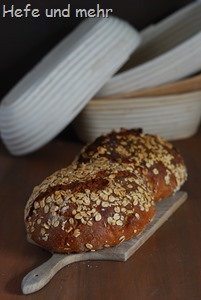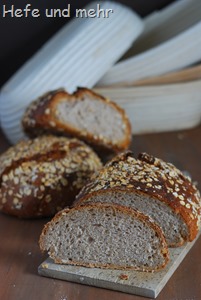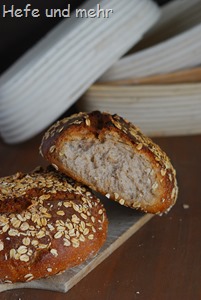 The second bread wich I baked for the “Schwarzmarkt” was a oatmeal bread. My love for oat shines through one or the other recipe and so I made up my mind quite fast that a bread with oats would be a “must have” for the Schwarzmarkt. This time I opted for a rolled oats partly as porridge, and partly roasted. The porridge makes the bread moist and keeps it fresh for a long time, while the roasted oats add flavour and a nice texture to the crumb. The bread is risen by only the sourdough and rye poolish, which makes the flavour deep and complex.
The second bread wich I baked for the “Schwarzmarkt” was a oatmeal bread. My love for oat shines through one or the other recipe and so I made up my mind quite fast that a bread with oats would be a “must have” for the Schwarzmarkt. This time I opted for a rolled oats partly as porridge, and partly roasted. The porridge makes the bread moist and keeps it fresh for a long time, while the roasted oats add flavour and a nice texture to the crumb. The bread is risen by only the sourdough and rye poolish, which makes the flavour deep and complex.
To get four breads into the oven, I decided to bake them as “Twins” which means that I proof two round loaves in one oval proofing basket. The breads fuse while baking on the side they touch each other, but are easily seperated when cooled down.
I like my oat twins very much, with their dark crust and moist crumb, and the slight honey flavour in combination with nutty oats it is harmonize with cheese as well as with honey or jam. A bread, suitable for every meal!
Oat Twins
yields 4 Breads of 500g each
Rye poolish
- 400g Water
- 200g whole rye flour
- 1g fresh yeast
Sourdough
- 150g flour Type 550
- 150g Water
- 15g Sourdough
Porridge
- 200g rolled oats
- 350g Water
Dough
- 650g Flour Type 550
- Rye poolish
- Sourdough
- Poolish
- 50g rolled oats, roasted
- 60g honey
- 20g Salt
Topping
- abou 30g rolled oats
For the rye poolish dissolve the yeast in the water and mix with flour. Let rise for about 14-16 hours.
Mix the ingredients of the sourdough and let it rise at 25°C for about 14-16 hours..
Bring rolled oats and water to boil. Remove from heat and let cool for for at least one hour
Now knead all ingredients 5 min at the slowest speed and 8 min at higher speed until medium gluten development.
Let rise for 1.5 hours
Divide the dough into four equal parts and form to rounds breads. Turn the loaves in rolled oats and place in two breads into one oval floured proofing baskets.
Proof for about 2 – 2.5 hours.
In the meantime heat the baking stone at 250°C .
Place the breads in the oven with steam. Bake the loaves for 10 min at 250°C, then turn the temperature back to 180°C and bake the bread for another 35 min .
Deutsch



Guten Morgen, ich mag den Hafer-Geschmack in Brot sehr und wollte fragen ob ich einen Teil der Mehls durch gemahlenen Hafer ersetzen könnte? LG Christina
@Christina: In geringen Maßen ja, weil Hafermehl ja kein Gluten enthält. Du kannst dich an diesem Rezept orientieren, nur statt Buchweizen- nimmst du Hafermehl.
Vielen Dank für den Tipp, habe daraufhin auch gleich noch das Hafergrützbrot ausprobiert. Toll! Auch wenn es immernoch nicht so nach Hager schmeckt wie das Brot von Biobäcker. Allerdings ist das auch deutlich “krümeliger” und nicht so schön weich wie deins. Da muss man wohl Abstriche machen wegen des fehlenden Glutens… Deine Rezepte sind jedenfalls ein Traum! 👍
Hallo Stefanie, ich backe gerade die Haferzwillinge und habe eine Verständnisfrage. Kommen die gerösteten Haferflocken in den Teig oder sind die zum Wälzen gedacht? LG
@Jens: Die gerösteten Haferflocken kommen in den Teig, zum Wälzen brauchst du nochmal eine Handvoll nicht-geröstete Haferflocken (die ich im Rezept vergessen habe – Sorry!). Ich aktualisiere das Rezept gleich mal!
Hallo Stefanie!
Die Haferzwillinge sind gut geworden. Vom Geschmack her sicher nicht jedermanns Sache. Ich werde mit dem Rezept aber noch ein wenig experimentieren. LG
@Jens: Freut mich, dass sie dir gefallen. Man muss bei diesem Rezept eine gewisse Honigsüße schon mögen, ansonsten muss die Honigmenge halbiert werden, dann verschmilzt sie mit dem Hintergrund.
Hallo Stefanie, vielen Dank für die schnelle Antwort. So habe ich es auch verstanden, war mir aber nicht ganz sicher. Ich werde berichten, was aus den Zwillingen geworden ist. LG
Vielen Dank fuer den Tip, es ist ein Versuch wert.
Hallo Stephanie,
ich hatte das Brot letztes Wochenende nachgebacken und es hat super geschmeck! Koennte ich eventuell statt 550 Mehl auch Vollkorn Dinkel nehmen?
VLG,
Maru
@Maru: Schön, das es dir geschmeckt hat 🙂 Vollkornmehl ist kein Problem, es kann allerdings sein, dass du 10-20g mehr Wasser brauchst. Beim Geschmack kann es sein, dass das Brot einen Tick mehr Säure entwickelt, da die Bakterien in Vollkornmehl mehr Nährstoffe vorfinden und sich stärker vermehren.
Vielen Dank Stephanie!
Hallo Stephanie,
kann ich statt Haferflocken Haferschrot nehmen?
LG,
Maru
@Maru: Das kannst du machen. Je nach Feinheit des Schrotes musst es aber etwas länger kochen, und evt. auch die Wassermenge reduzieren.
Hmmm sieht toll aus, aber ich glaub, beim Poolish fehlt die Hefeangabe 😉
Könnte man evtl. den Teigling auch über Nacht kalt reifen lassen?
Herzlichst
Nadja
@Naddi: Danke für das aufmerksame Lesen, die Hefe steht jetzt da, wo sie hingehört 😀
Und eine kalte Übernachtgare sollte sehr gut gehen!
MEI DES duftet bis zu mir…..
hob no an feinen TOG
bis bald de BIRGIT